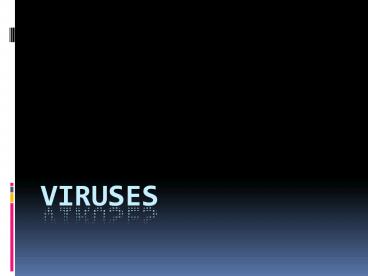Viruses - PowerPoint PPT Presentation
1 / 15
Title: Viruses
1
Viruses
2
I. Introduction to Viruses
- Viruses are very small, much smaller than
bacteria. - Viruses are not living organisms
- Do not have a cellular structure.
- Does not metabolize food.
- Cannot reproduce outside host cell.
The SARS virus. (There are 1,000,000 nm in 1 mm)
3
C. Viral Reproduction
- Viruses reproduce by inserting their genetic
material into a host cells DNA and forcing the
cell to replicate the DNA.
The virus injects DNA into the cell
A virus approaches a bacterial cell
4
D. Viral Anatomy
- An individual virus particle is called a phage.
- A virus is made of DNA or RNA and a protective
protein coat, called a capsid. - Some viruses also have a lipid bilayer membrane.
- Prophage viral DNA inserted into the host cells
genome
5
E. Model Virus Anatomy
- Bacteriophages consist of
- a head, which holds the viral DNA
- a sheath
- a core, which pierces the bacteria so that DNA
can enter the cell - feet which have the binding proteins that help it
attach to a bacteria cell.
6
II. Viruses and Disease
- Viral disease is caused by two things
- When a virus takes over a cell, it can no longer
perform its role in the body. Some symptoms are
the result of non-functioning cells. - Inflammatory response The bodys response to
infection like fever, swelling, increased white
blood cell production, killing infected cells,
and extra mucous.
7
B. The Lytic Cycle
- The virus takes over a cell causing it to make
more viral DNA until the cell explodes which
releases the new phages.
8
C. The Lysogenic Cycle
- The virus inserts its DNA into the host cell but
stays dormant. The virus DNA is replicated every
time the cell divides. - All viruses eventually enter the lytic cycle,
- triggered by environmental conditions, immune
response, or number of infected cells
9
(No Transcript)
10
III. Other Types of Virus
- Viroids are short sections of virus RNA that
infect plants. These have a major economic
impact in agriculture. - Bacteriophages are viruses that infect bacteria.
Helpful in getting rid of bacterial infections
and in cloning genes.
11
III. Other Types of Virus
- Retroviruses are RNA viruses containing a reverse
transcriptase so that their RNA can be copied to
DNA before insertion in the host cell. Example
HIV - Prions are misfolded proteins that cause an
organisms proteins to misfold. How prions
actually cause disease and reproduce is still a
mystery. Diseases like mad cow disease are
caused by prions.
12
Prion
13
IV. Virus Origins
- Scientists are unsure how viruses originated but
have developed a few hypotheses - Viruses may have once been small cells that
parasitised larger cells. Over time, genes not
required by their parasitism were lost. - Viruses may have evolved from bits of DNA or RNA
that escaped from the genes of a larger organism.
Possibly from plasmids or transposons. - Viruses may have evolved from complex molecules
of protein and nucleic acid at the same time as
cells first appeared on earth.
14
V. Virus Evolution
- Viruses evolve quickly, because they reproduce
quickly. However, virus DNA must remain short
otherwise it will take too long for the cell to
copy. - Viruses mutate once every time they are
replicated, so new mutations are very common. - Viruses can adapt to changes in their environment
in only a few months.
15
VI. Viruses and Medicine
- Anti-viral drugs mainly work to keep viruses in
the lysogenic cycle. - Resistance to antiviral drugs appears within
weeks. - Vaccines work by introducing a virus related to a
disease, or by introducing the capsid proteins,
so that the immune system creates antibodies to
target that virus. - Vaccines that target parts of the virus that
rarely change, like the receptors necessary to
attach to a cell, last for a long time (polio
vaccine). Other viruses (cold, flu) do not.































